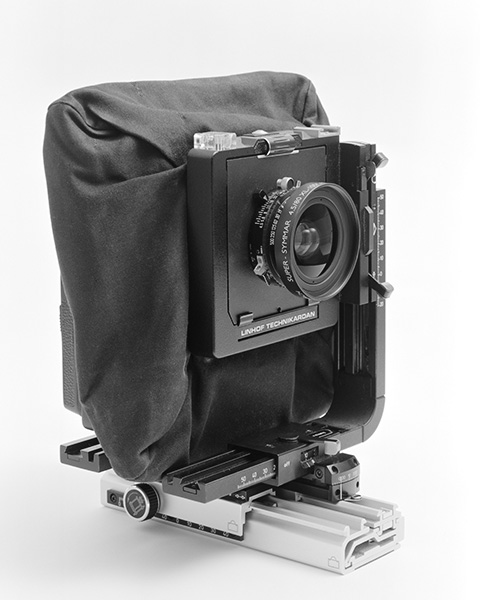
The images on this site were scanned from black & white negatives taken with an adjustable view camera. Monochrome was chosen for its unrivalled ability to reveal form and texture without the distraction of incidental colour.
But why take this old-fashioned approach in our brave new world of digital?

For every exposure, I have to mount a 3.5 kg camera on a sturdy tripod and compose and focus the image upside-down on a ground glass screen with a black cloth over my head to exclude extraneous light. This is quite a pantomime on a Cambridge pavement with thousands of visitors streaming past. I then have to develop the sheets of film by hand in total darkness before scanning and final adjustment in image editing software.
So why would I go to all this trouble to produce images which are frequently dismissed by camera club judges as mere "record shots"?
Well, if you were to ask painters why they still bother with messy paints, when they could do so much with a digital camera and Photoshop, I suspect they would tell you two things: that they like the results they obtain; and they enjoy the process itself.
My reply would be the same.
Having studied the work of great architectural photographers such as Ezra Stoller, Cervin Robinson and Julius Shulman, I firmly believe in verticals usually being properly corrected (or ever-so-slightly undercorrected), and the most versatile tool for this is the view camera, the basic design of which has scarcely changed since Victorian times.
Certainly, some limited perspective correction is possible in Photoshop, and a few tilt-and-shift lenses are available for digital cameras. However, a single T&S lens costs twice as much as I paid for my secondhand Linhof Technikardan camera, which takes 5"× 4" sheet film. Furthermore, the movements are much more extensive and versatile than a T&S lens, and as the movements are built into the camera, every lens I possess, from 47mm to 300mm, has the tilt and shift functionality.
And as for that derogatory term "record shot", I suggest that virtually all the great photographs of the 19th and 20th centuries could be so classified, while their more "creative" contemporaries have largely disappeared without trace. The images I aspire to taking are timeless, if unremarkable.
Indeed, that very unremarkability is often the hallmark of a good architectural image, wherein the technical difficulties have been so skilfully managed that the image looks to the unobservant critic like a simple snapshot. Commenting on a Morley Baer image, Cervin Robinson wrote, "The effortlessness with which this ...... seems to have been taken ..... belies the care and craftsmanship with which it was actually made".
I indicated earlier that I find the process of using a view camera extremely enjoyable, in spite of the weight I have to carry around. I believe that all dedicated view camera users find something almost magical about that inverted image on the ground glass. Whenever I show it to interested passers by in Cambridge, whether to local photography students or curious visitors from China, the universal reaction is "Wow!" Ansel Adams expressed it in rather more articulate fashion as follows: "Although my mind assures me that I should be able to visualize a fine image no matter what camera I use, I find a particular conviction and pleasure in viewing a large view camera image on the ground glass. These images are a delight to behold, even if no photograph is made!"
My photography of buildings in Cambridge began as a technical exercise to teach myself the techniques of view camera photography. Although I have practised photography as a self-taught amateur for over 60 years, it was only comparatively recently that I finally ventured into the large format field myself. Soon my photographic forays into Cambridge took on a life of their own, and I began to take architectural photography increasingly seriously.
As the number of images grew, the question arose as to what to do with them. I therefore created this site so that they could be seen and hopefully enjoyed. Since then my photography has begun expanding into the county outside Cambridge itself. This is not an e-commerce site, and I harbour no illusions as to any commercial demand for such images. For me this is something of a labour of love. However, if anyone should wish to use any of my photographs, I invite them to contact me on roger@rogerfletcher.plus.com.
Roger Fletcher, Cambridgeshire 2022